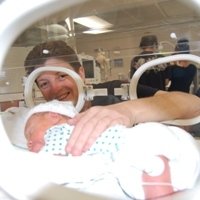
Wednesday, 18 May 2011
Jane Pillow's father always wanted her to study mathematics. Now the Professor of Neonatology might be wishing that she had.
Professor Pillow, from the School of Women's and Infants' Health, is collaborating with Winthrop Professor Andrew Bassom from the School of Mathematics and Statistics to investigate High Frequency Oscillatory Ventilation (HFOV) for preterm babies.
"HFOV has been used clinically for about 25 years but it hasn't demonstrated itself to be vastly better than other forms of ventilation and we don't know why," Professor Pillow said. "So I asked Andrew to do some mathematical modelling to help us understand some of the factors involved."
Professor Pillow's father, Albert Fenton Pillow, was a Professor of Applied Mathematics at the University of Queensland and he left a legacy for research into Applied Mathematics. She is the Chair of the Trust which provides funding to promote the study John Moore at the Zadko Telescope of Applied Mathematics in Australia.
It was through the Trust that she and Professor Bassom first met. His specialist area of research is fluid dynamics, the same area in which Professor Fenton Pillow worked.
"There is a lot of engineering in the way a ventilator works and ventilation is an integral part of neonatal care for preterm babies," she said. "Many of my collaborations have been with engineers - respiratory mechanics are actually fluid dynamics. But this is the first time I've worked with applied mathematicians."
Professor Pillow's work is at the interface of medicine, mathematics and engineering.
"As medicine becomes more technical, we need to collaborate more and more with mathematicians and engineers to understand and refine our tools for diagnosis and treatment," she said.
Her current grant from the NHMRC is looking at HFOV , which delivers 600 to 900 very small breaths per minute, compared with a baby's usual breathing rate of 40 to 60 breaths per minute. "These small rapid breaths means that the baby's chest is really just vibrating gently. When first introduced, this method showed great promise in the laboratory for dramatically decreasing injury to the lungs of the newborn as it doesn't stretch the incompletely-developed air sacks of the preterm baby.
"We thought it would be a saviour for our babies but in clinical practice it hasn't shown the benefits over conventional ventilation that we expected and we are puzzled."
She said some babies on HFOV developed floppy airways. "So it may be that HFOV protects the lungs at the expense of the airways. We are concerned that the turbulent high frequency reversing oscillatory flows could be inducing a mechanical shear force on the walls of the more central airways, weakening them."
Enter the mathematicians. They will model HFOV flows through a baby's airway to calculate the shear stress on the airway wall and be able to tell the medical team where they expect it to be at a maximum. They will try to determine at what ventilator settings they expect the injury might occur; and help their medical partners to understand more about the factors that influence shear stress.
"We will break it down to the simplest form," Professor Bassom said. "We will model how fluids work in airways. Within fluid dynamics, my work is in the area of oscillating flows, so this is the perfect fit for me.
"It's not necessary for me to see a preterm baby breathing with a ventilator, but Jane is going to take me to see one. It makes the research real and I like the contact with reality," he said.
While their research might one day be a matter of life and death, the colleagues can see an amusing side of their collaboration.
"My father had the last laugh," Professor Pillow said.
(2011 is the Year of Mathematics at UWA.)
Published in UWA News , 16 May 2011
Tags
- Channels
- Research
- Groups
- UWA Forward